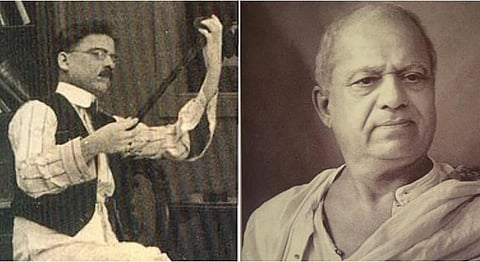
- HOMEGROWN WORLD
- #HGCREATORS
- #HGEXPLORE
- #HGVOICES
- #HGSHOP
- CAREERS
- ABOUT US
- CONTACT US

Year 1913. Complete darkness around. People were sitting on the edge of their seats, excited about what is about to happen. Enclosed inside the Coronation theatre, the audience was holding their breaths, facing a clean white curtain. And suddenly a king, in monochrome, was moving on the curtain. He was interacting with his fellow companions through profound action delivery. Exclaims of astonishment and admiration lightened the tenerosity. No sound was heard, but the intertitles connected the entire narrative. Multiple characters came up, an eponymous legend was conveyed in those forty minutes. And hence, India’s first full-length feature film was born.
In the days when cinema was in infancy, Dadasaheb Phalke, known as the “Father of Indian Cinema”, brought the idea of motion picture to the Indian soil. A perfectionist and strict disciplinarian, he was a man who nurtured various talents like photography, architecture, amateur dramatics, lithography and also magic. A painter, set designer and cinematographer, he played all these roles in his films. He introduced the people of India to the magical cinematic experience and evolved the largest entertainment industry in the world.
Passionate about creative arts, he pursued his education from JJ School of Arts in Bombay and Kala Bhavan in Baroda, where his skill sets were given a boost. His career began as a photographer in Godhra, but had to give it up after his wife and child’s demise. Later, Starting a press of his own, he travelled to Germany to enquire about the latest technology and machinery for the same, but that too had to stop.
His journey as a filmmaker began in 1911, when a European film, The Life of Christ, screened in Bombay, inspired him to make films based on Indian stories. At that time, he was working with the famous painter, Raja Ravi Varma, who portrayed Indian gods and goddesses, the future inspiration for themes in Phalke’s films. This silent film marked the turning point of his career, with the only mission to bring all that was Indian to the screen. But the lack of required information and technology forced him to go to London to learn the craft of filmmaking from the cinema pioneer, Cecil Hepworth.
He returned, with the Williamson camera and other vital equipment and began the process of creating the first ever film. Finally, after collective and tedious efforts of his family members, friends and other helpers, and shooting for six months and twenty-seven days, India saw its first film, Raja Harishchandra, on 3rd May, 1913. A film of 3,700 feet, a very few portions of it is remaining today. It was a huge success and a historic milestone in Indian cinema. He further experimented with a variety of special effects and trick photography, which was highly appreciated by the audience.
In 1917, he began the Hindustan Film Company production house. Throughout his 19 year old film career, he made 95 feature length films and 27 short films. Some of his greatest hits were Lanka Dahan (1917), Shri Krishna Janma ( 1918), Sairandiri (1920), Shakuntala (1920) and Guru Dronacharya (1923) amongst many more. “Gangavataran (1937)”, which proved to be his last film, he successfully imbibed sound in it, to make it more lively.
We lost this great man on February 16th, 1944, in Nashik, British India Bombay. Today, a very prestigious award is named after him to honour extraordinary achievements in the field of cinematography.
Do watch the movie “Harishchandrachi Factory”, by Srirang Godbole and Paresh Mokashi, capturing the beautiful but a hard journey of cinema’s entry in the Indian world.
If you enjoyed reading this article, we suggest you read:
